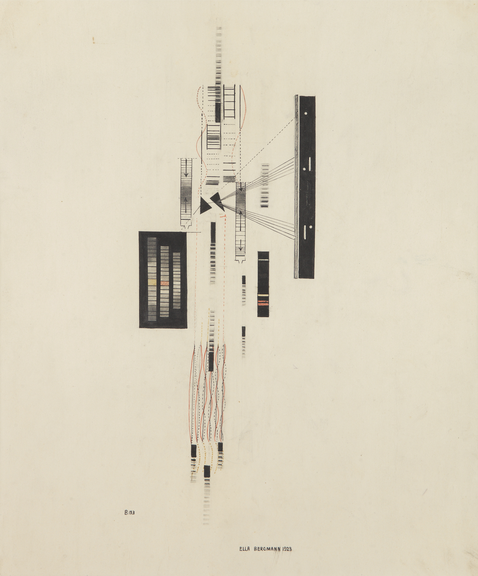Vienna. The layout of Galerie Meyer Kainer lends itself well to narrative, and Florian Pumhösl knows it. For his “Curated by” exhibition, the artist has arranged the course of its three rooms like a musical score. At the street entrance the melody is established and our curiosity triggered. Then, in the large central space, follows a sequence of verses divided by a chorus. Here, some drama plays out. The upstairs is just large enough for some kind of resolution, no grand finale but the curl on the pig’s tail. What appears as a display of the most minimal abstraction is rendered almost figurative by the tight narrative structure of Pumhösl’s assemblage. You have to listen quite carefully, but there’s a lot going on.
The melody established in the entrée is structured by three positions: two of Henrik Olesen’s resin milk cartons, both Untitled (2019); a drawing by Ella Bergmann-Michel, Untitled (black light) (B173) (1923); and Pumhösl’s own Formed Speech 2019 – Negative 5 (2019), a slim shape in black granite. The combination, frankly, is thrilling. In Olesen’s cheeky milk cartons, we see a product without its declaration, content liberated from the social construct of its surface. Meanwhile, with her geometric abstraction, Bergmann-Michel has turned technology inside-out, so to speak, arranging wires and disks like a landscape, or the other way around, making a stringent grid of nature’s wild intricacies. Pumhösl’s negative shape posits a different theory of the non-indexical object. Rather than peeling away the surface, like Olesen, or, like Bergmann-Michel, developing an image from what usually isn’t seen, he shows us the Thing as absence, imprint, or trace. An inverted rhythm that divides as well as connects is played in the reveal-conceal dynamics among the trio.
The main room contains three verses, each framed by specimens of Pumhösl’s Formed Speech series. One is the door to the gallery’s office – negative space not as formalized imprint but in its natural habitat. Clever. In another, it’s possible to detect a very understated conflict between two austere works by Ad Reinhardt and Alan Charlton, respectively. Reinhardt – who built on the foundation of someone like Bergmann-Michel – insisted on abstract art as pure, disinterested, and separate from daily life. But his Untitled (1952) is not as strict as they tend to come from his hand. In fact, in the company of Charlton’s skinny gray Line Painting (1979), far more brutal in its formal rigor, Reinhardt’s composition on dark blue looks positively poetic. But it was Charlton who chose to work in concrete gray precisely for its emotive resonance, for what it tells of life in bleak industrial cities. Though Charlton stares dire mundanity in the face and Reinhardt looks away, both paintings have the visual impact of a solemn intake of breath. Not so different at all.
In the third verse, Anita Leisz puts a theatrical end to the melancholic gentlemen’s tiff with her Untitled (2016) sculpture. This fragment of a room, a box, or a coffin lined with ash-colored contouring is not lacking mystery. What happened? What other story did this prop fall out of? From here, we might look back at Reinhardt’s stubborn purity and ask: Why are you so afraid of the mess? Leisz, like Olesen, is the stray note that interrupts the rhythm just because it can.
For the outro upstairs, Pumhösl takes us back to Bergmann-Michel’s 1920s. Here, a duet plays out between Wacław Szpakowski, a mostly-architect who experimented privately throughout his life with continuous line drawings, and Dadaist Christian (Georges Herbiet), whose diagrams purport a faux-scientific (faux because Dada?) “global aesthetic.” The works bridge the semantic fields of science-technology-nature and compulsion-abstraction-emotion that run through the exhibition. Szpakowski clearly attempted to understand something about the relationship of shapes to rhythm and continuity, and knew that he had to reach that understanding intuitively, practically. With this in mind, there’s a surprisingly tentative and questioning element to his otherwise inhumanly perfect patterns. And this, in the end, is also the essence of Pumhösl’s black granite refrain: abstract minimalism is a question directed at the fundamentals of life, an attempt to untangle the technical nitty-gritty of space, signs, and even such soft attachments as memories and emotions. I much enjoyed the music.
